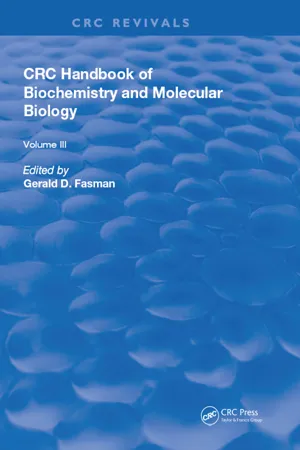
This is a test
- 633 pages
- English
- ePUB (mobile friendly)
- Available on iOS & Android
eBook - ePub
Book details
Book preview
Table of contents
Citations
About This Book
This edition focuses solely on proteins, amino acids venom toxins and peptides, haemoglobin. It also gives us very detailed information regarding cell types, anti-bodies, infrared testing on protein cells and membrane studies.
Frequently asked questions
At the moment all of our mobile-responsive ePub books are available to download via the app. Most of our PDFs are also available to download and we're working on making the final remaining ones downloadable now. Learn more here.
Both plans give you full access to the library and all of Perlego’s features. The only differences are the price and subscription period: With the annual plan you’ll save around 30% compared to 12 months on the monthly plan.
We are an online textbook subscription service, where you can get access to an entire online library for less than the price of a single book per month. With over 1 million books across 1000+ topics, we’ve got you covered! Learn more here.
Look out for the read-aloud symbol on your next book to see if you can listen to it. The read-aloud tool reads text aloud for you, highlighting the text as it is being read. You can pause it, speed it up and slow it down. Learn more here.
Yes, you can access Handbook of Biochemistry by Gerald D Fasman in PDF and/or ePUB format, as well as other popular books in Medicine & Biochemistry in Medicine. We have over one million books available in our catalogue for you to explore.
Information
Proteins
OPTICAL ROTATORY DISPERSION AND CIRCULAR DICHROISM OF PROTEINS*
Biot in 1836 introduced the term specific rotation, [α], for the optical activity of a compound1, 2, 3
(1) |
where
α | = | the observed rotation of the plane of polarized light in angular degrees at wavelength λ |
ℓ | = | the optical path in decimeters; |
c | = | the concentration of the compound in grams per milliliter. |
The dimension is deg cm2 decagram–1. The traditional use of specific rotation at sodium D line, , is now obsolete with the availability of modern spectropolarimeters. Here D refers to 589 nm and t the temperature in centigrade.
For biopolymers, the data are usually expressed in terms of mean residue rotation, [m]
(2) |
where M0 is the mean residue (molecular) weight. (Some workers prefer the symbols [ϕ] or [R] for [m] and MRW for M0.) M0 of a protein can be determined from its amino acid composition (for most proteins, M0 ≅ 115). Moffitt4 introduced the term reduced mean residue rotation, [m′], by including a Lorentz field correction
(3) |
which reduces [m] to that under vacuum, noting that the refractive index is unity in vacuum. The dimension of both [m] and [m′] is deg cm2 dmol−1.
Optical rotatory dispersion (ORD) in the visible region of most proteins obeys the Drude equation
(4) |
where λc and k are the dispersion and rotatory coefficients. A plot of λ2 [α]λ vs. [α]λ yields a straight line with as the slope and k as the intercept (at [α]λ = 0).5 The Moffitt equation for α-helical polypeptides4
(5) |
has now replaced the Drude equation for the ORD of proteins (except collagen). By rearranging Equation 5 into
(6) |
the b0 and a0of a protein can be determined from a plot of [m’](λ2/λ02 – 1) vs. 1/(λ2/λ02 – 1) with λ0 usually preset at 212 nm. A b0 of-630 deg cm2 dmol−1, based on the data of synthetic polypeptides, is regarded to represent a perfect helix. The Moffitt equation, now considered to be empirical, still provides a reasonable estimate of the helical content in a protein molecule. Both Equations 4 and 5 are only applicable over a certain wavelength range. Often a λ0 larger than 212 nm must be used when the data below 300 to 350 nm are included for the fitting of the Moffitt equation. For the convenience of comparison, we will list only the a0 and b0 values based on λ0 = 212 nm (with a few exceptions).
The visible ORD can also be fitted with many two-term Drude equations
(7) |
One such equation has been proposed by Shechter and Blout6 with λ1 = 193 and λ2 = 225 nm. All these equations can be reduced to the Moffitt equ...
Table of contents
- Cover
- Half Title
- Title Page
- Copyright Page
- Dedication
- Table of Contents
- PROTEINS
- INDEX